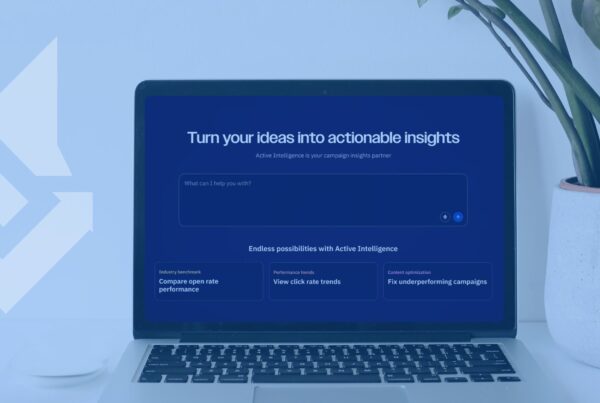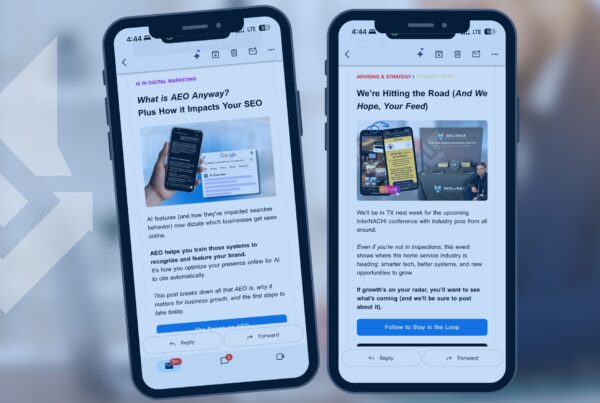Last updated on October 31st, 2025 at 01:15 pm
Would you trust a business with no reviews? Most people wouldn’t, and there are reasons for that! They tell potential customers what to expect and provide a sense of trust before any interaction even begins. A great review gallery hinges on your plan for when and how to request a review about someone’s experience.
Whether it’s a concise 5-star review or something more detailed, each one shapes how a business is perceived online. This post breaks it down step-by-step so you can start building trust, boosting visibility, and growing your brand today.
Contents
Why Reviews Matter (More Than Ever)
Customer reviews aren’t just an extra—especially heading into 2025. As search engines evolve and competition online becomes fiercer, reviews play an increasingly hefty role in helping your business stand out.
Visibility
Search engines like Google use reviews as key ranking signals. Consistent, positive feedback tells algorithms that your business is active, reliable, and trusted by customers.
- Updates to Google’s core algorithms place even more emphasis on engagement and fresh, user-generated content like reviews.
- Local businesses with frequent, high-quality reviews tend to rank higher in “near me” searches, increasing your chances of being discovered by nearby customers.
Social Influence
Most people trust recommendations from others, even if they’re strangers. Reviews give potential customers a glimpse into what working with your business is like:
- Positive reviews act as endorsements, helping people feel more confident in choosing your services.
- The reassurance of seeing real experiences can nudge a hesitant prospect into taking action, whether that’s scheduling a service or making a purchase.
Stronger SEO
Search engine rankings aren’t static, but dynamic. They’re shaped by user behavior and evolving algorithms that are rarely predictable. Reviews support your SEO strategy by:
- Generating fresh content that search engines prioritize.
- Increasing click-through rates when potential customers see a high star rating in search results.
- Creating engagement metrics that signal relevance and authority to Google, boosting your visibility.
Reviews also allow customers to share unfiltered, authentic feedback. That builds trust faster than any marketing copy. A business with a variety of reviews and engaged responses appears more transparent and trustworthy.
Beyond building trust online, the reviews you collect are also a resource to better understand your audience and fuel future growth. Patterns in their feedback can guide service improvements, product changes, or adjustments to your customer experience.
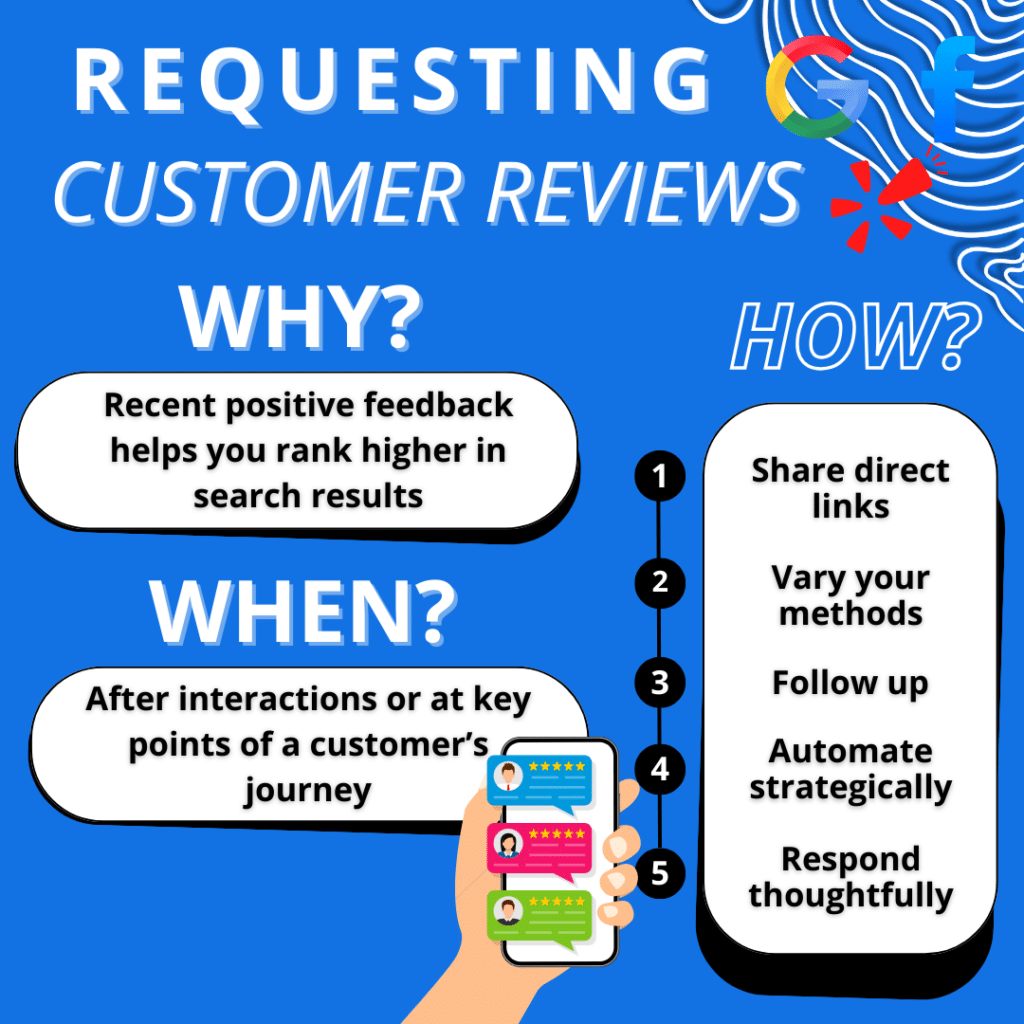
When is the Perfect Time to Ask for a Review?
Timing is everything when it comes to getting great reviews. Asking at the right moment ensures your request feels natural and increases the chances of a positive response.
Right After a Positive Experience
The best time to ask for a review is when the customer’s experience is fresh in their mind. This could be immediately after completing a service, delivering a product, or resolving an issue.
When customers are satisfied, they’re more likely to leave a thoughtful review that reflects their experience.
Key Points in the Customer Journey
Identifying the right milestones in your process makes it easier to know when to ask. The customer journey might look a little different from industry to industry and even company to company, but here are a few ideal moments:
- After successfully completing a service or project.
- Following delivery of a product, once the customer has had time to use it.
- When a customer expresses satisfaction verbally or through email (e.g., “I love what you’ve done!”).
- After resolving a complaint or concern, when the customer feels valued and heard.
Following Up Thoughtfully
If a customer doesn’t leave a review right away, a follow-up can serve as a polite reminder. Automated follow-up emails or text messages, sent within a few days of the initial interaction, can help you stay top of mind without feeling pushy.
Timing isn’t just about asking, but also about showing you value the customer’s experience and making it easy for them to share their thoughts.
When you align your review requests with natural points in the customer journey, the process feels seamless and respectful.
How to Request a Review the Right Way
Asking for reviews doesn’t have to feel awkward or pushy. While showing genuine appreciation for their time and feedback, here’s how to approach your request.
1) Keep it Simple and Personal
- Use friendly, concise language that’s easy to understand.
- Personalize your request to reflect the specific service or interaction you had with the customer.
- Show gratitude and explain how their feedback helps others make informed decisions.
2) Offer Clear and Easy Steps
The easier it is for customers to leave a review, the more likely they’ll follow through. Provide simple instructions or direct links to review platforms like Google, Yelp, or Facebook.
Also, let them know their feedback doesn’t have to be lengthy—short, honest reviews are valuable too. A phrase like, “It only takes a minute, but it means the world to us,” helps manage expectations.
Show appreciation up-front by starting your request with a sincere thank-you for their time and trust in your business. Gratitude sets a positive tone and reinforces that their opinion matters.
3) Use Appropriate Methods
Different customers respond to different methods, so choose what works best for your audience:
- Email Follow-Ups: Send a thank-you email shortly after their experience with a direct link to the review platform.
- Text Messages: Use SMS for a quick, mobile-friendly request.
- In-Person Requests: If you have direct contact with the customer, train your staff to ask naturally at the end of a service.
- Website Prompts: Add a review request pop-up or a thank-you page after checkout or service completion.
- Social Media Campaigns: Create engaging posts encouraging customers to share their feedback and include links for easy access.
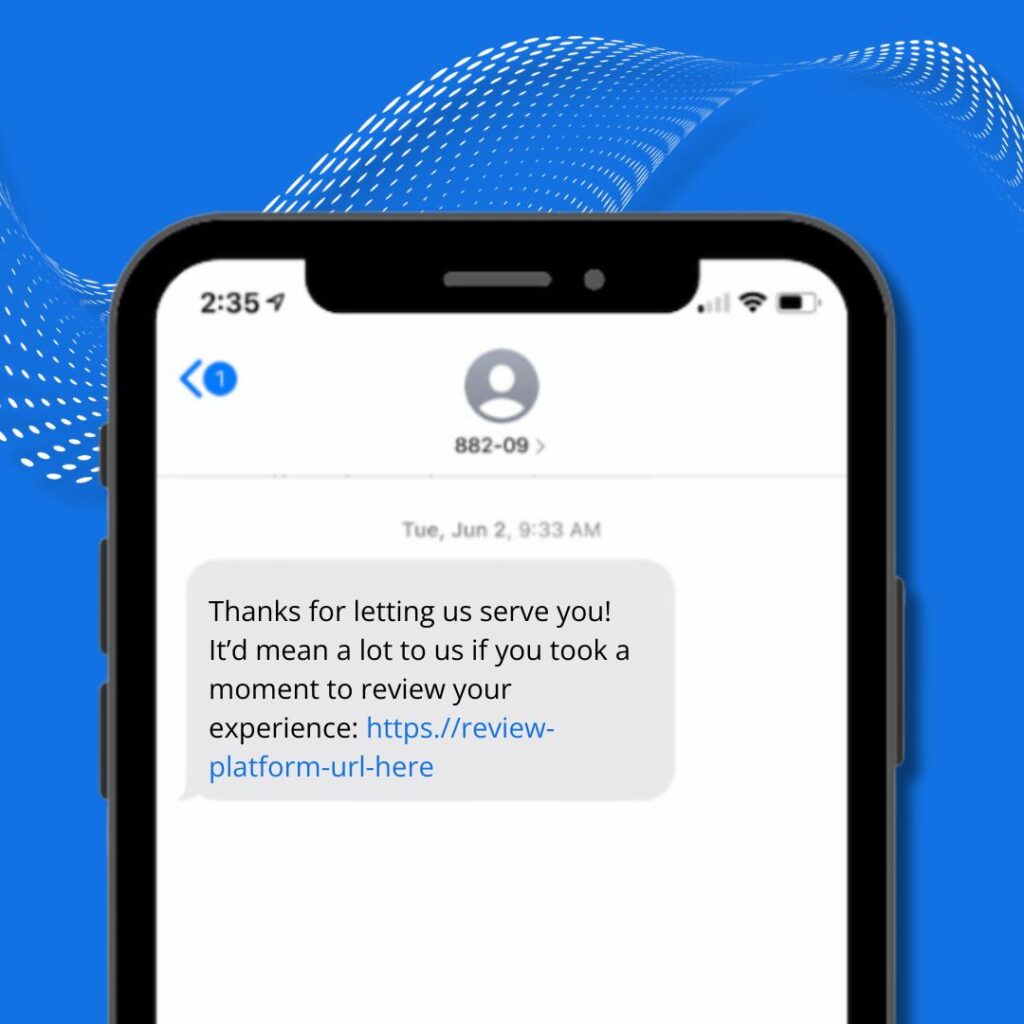
4) Automate Them
Tools for automating your review requests can make sure they’re consistent, timely, and easy to manage. That’s pressure taken off you while creating a smoother customer experience.
- Schedule follow-ups to automatically send shortly after a service or purchase. That way, every customer receives a review request without you having to track each one manually.
- Provide direct links to review platforms like Google or Yelp in your automated requests. This eliminates extra steps and makes it easy for customers to share their feedback quickly.
- Set the right timing considering the best moments for your business, like a day or two after a service. Now, the experience is still fresh in the customer’s mind but they haven’t been hounded.
- Stay consistent, but don’t overwhelm. Automated systems help you keep review requests consistent while spacing them out appropriately, so customers don’t feel pressured.
5) Emphasize their Easy Impact
Getting more reviews starts with creating a process that feels natural, easy, and rewarding for your customers. Think of reviews as the final step in your service, not an afterthought.
For example:
- End a service with a simple, friendly mention: “Before wrapping up, we’d love to hear your feedback.”
- Include a review request in your follow-up communication, like an email or text, thanking them again for choosing your business.
Show customers how their reviews make a difference.
- Highlight how reviews help other people find and trust your business.
- Mention how feedback allows you to keep improving your services.
When customers see the bigger picture, they’re more likely to feel that leaving a review is meaningful, not just transactional.
Responding Effectively
The way you respond to customers online refers to more than good manners. It’s an opportunity to build trust, improve relationships, and show potential customers that you care.
Most customers who leave bad reviews (about 67%) will return if their review gets a speedy response.
Every review, whether positive or critical, deserves a thoughtful and professional response. When a customer takes the time to leave a review, responding shows appreciation and strengthens the connection.
Your response carries almost as much weight as the initial review does, so:
- Be Personal: Use their name if available and reference specifics from their review, like the service or product they praised.
- For example: “Thank you, Sarah! We’re thrilled you enjoyed your [service experience]. Your feedback motivates us to keep delivering top-notch service.”
- Reinforce the Experience: Mention how their comments reflect your business’s values, like customer care or quality work.
- Encourage Engagement: Invite them to return or share their experience with others.
Negative reviews can feel discouraging, but they’re a chance to showcase your professionalism. For both of those reasons, they should be handled with care—here’s what that can look like:
- Acknowledge Their Experience: Begin with empathy and understanding: “We’re sorry to hear about your disappointment. This experience definitely doesn’t reflect our standards, and we’d like to make it right.”
- Provide a Path Forward: Offer a solution or invite them to connect offline to resolve the issue. For example: “Please contact us at [email/phone] so we can address this directly.”
- Don’t Argue: Stay calm and respectful, focusing on resolution rather than defensiveness.
Be Timely
Timely responses show that you value feedback and take customer input seriously. Aim to reply to all reviews—positive or negative—within a few days to keep the conversation relevant and fresh.
A prompt, personal, and thoughtful reply tells your customers—and anyone else reading—that their opinions matter and that your business is always striving to improve.
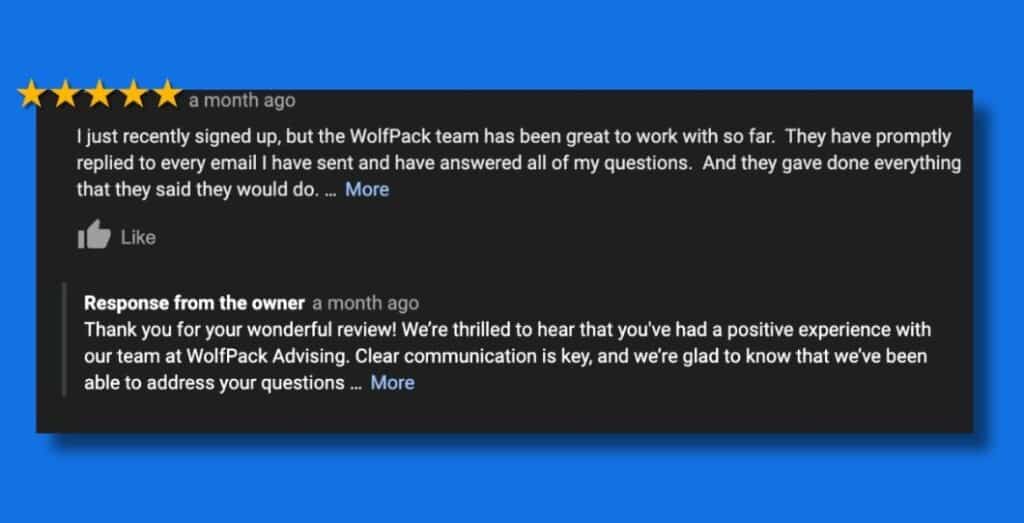
Putting Feedback into Action
Customer reviews are an untapped resource for growth. Each comment holds insights into what your business is doing well and where you can improve.
Positive reviews highlight what customers value most about your business and what sets you apart. Leverage this to fine-tune your marketing and operations.
- If reviews consistently praise your quick turnaround time, make that a selling point in your advertising, social media content, email campaigns, or website copy.
- Identify top-performing team members or services and use them as benchmarks for training and scaling success.
What’s Holding You Back?
Constructive criticism isn’t just negative—it’s a guide for improvement. Analyze patterns in less-than-stellar feedback, spot the trends, and act with intention.
- If customers frequently mention confusion during booking, simplify your scheduling process or create clearer instructions.
- Address recurring complaints by updating policies, retraining employees, or improving communication methods.
Refine Offerings Using Real Input
Take your customer feedback and consider it as you shape the future of your business. When reviews suggest missing services or features, consider adding them.
For instance, if customers express interest in weekend availability, evaluate the feasibility of making that happen. It can help to assess the resource input versus the risk of not making the change in question.
Reviews provide a wealth of data to guide strategic moves. Monitor which products or services customers mention most often to determine where to focus your resources.
Track shifts in sentiment over time to evaluate the success of new initiatives or content. Your customer feedback is a goldmine for creating relatable, impactful marketing strategies.
- Use real quotes from reviews in your social media posts, ads, and email campaigns. Highlight the specifics that resonate with your audience.
- Create blog posts or videos addressing common customer questions or concerns found in reviews, showing you’re attentive to their needs.
Close the Loop
Letting customers know their input drives change fosters loyalty and trust! Make sure nobody feels like their experience was allowed to slip through the cracks.
- Post updates on how suggestions influenced new services, improved policies, or upgraded offerings.
- Add a section to your website or newsletter titled “What We’ve Improved Thanks to You” to demonstrate accountability and growth.
Conclusion
When you ask for feedback thoughtfully, respond with care, and put those insights to work, you’re not just collecting reviews, you’re influencing new visitors, growing online, and creating stronger bonds with real people.
Empower folks to share their stories, and let your customers do the talking for your business! Our team can manage review requests, responses, or your whole marketing strategy—schedule your consultation today.



